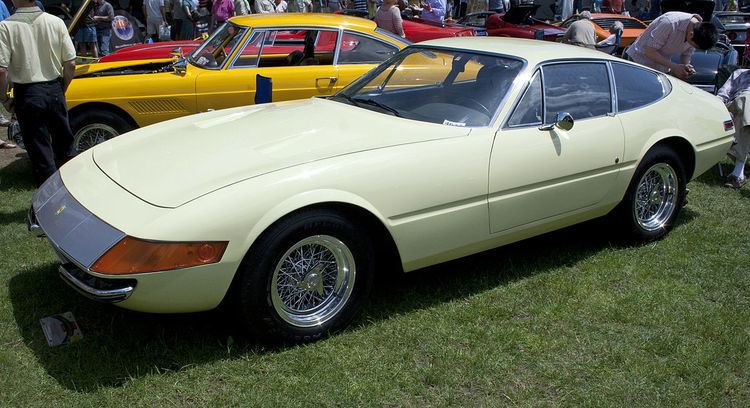 | ||
Production GTB/4: 1968–1973 1,284 producedGTS/4: 1971–1973 122 produced Body style GTB/4: berlinettaGTS/4: spider Layout Front-engine, rear-wheel-drive | ||
The Ferrari Daytona, officially designated the Ferrari 365 GTB/4, is a two-seat grand tourer produced by Ferrari from 1968 to 1973. It was introduced at the Paris Auto Salon in 1968 to replace the 275 GTB/4, and featured the 275's Colombo V12 bored out to 4.4 L (4,390.35 cc, 267.9 cid).
Contents
The Daytona was succeeded by the mid-engined 365 GT4 Berlinetta Boxer in 1973.
Name
The unofficial Daytona name is reported to have been applied by the media rather than Ferrari and commemorates Ferrari's 1-2-3 finish in the February 1967 24 Hours of Daytona with a 330 P3/4, a 330 P4 and a 412 P. To this day, Ferrari itself only rarely refers to the 365 as the "Daytona", and refer to it as an "unofficial" name.
Vehicle specifications
Unlike Lamborghini's then-new, mid-engined Miura, the Daytona was a traditional front-engined, rear-drive car.
The engine, known as the Tipo 251 and developed from the earlier Colombo V12 used in the 275 GTB/4, was a 4.4 L (4,390.35 cc, 267.9 cid) DOHC V12 with a 60° bank angle, 365 cc per cylinder, 81 mm (3.2 in) bore and 71 mm (2.8 in) stroke, featuring six Weber twin carburettors (40 mm Solex twin carburettors were used alternatively). At a compression ratio of 9.3:1, it produced 357 PS (263 kW; 352 hp) and could reach 280 km/h (174 mph). 0-60 mph (97 km/h) acceleration was just 5.4 seconds. For the American version, slight modifications were made - the compression ratio was reduced to 8.8:1 and the exhaust system was equipped with a large central silencer, necessitating visible alterations to the primary pipes.
The five-speed manual transmission (of the transaxle concept) was mounted in the rear for optimal weight distribution, and a four-wheel independent suspension featured wishbones and coil springs.
Styling
Although a Pininfarina design, as with many previous Ferrari road cars styled by Leonardo Fioravanti, the 365 GTB/4 was radically different. Its sharp-edged styling resembled a Lamborghini more than a traditional Pininfarina Ferrari.
Early Daytonas featured fixed headlights behind an acrylic glass cover. A new U.S. safety regulation banning headlights behind covers resulted in retractable pop-up twin headlights in 1971.
365 GTB/4 and GTS/4
The generally accepted total number of Daytonas from the Ferrari club historians is 1,406 over the life of the model. This figure includes 156 UK right-hand-drive coupés, 122 factory-made spyders (of which 7 are right hand drive), and 15 competition cars in three series with modified lightweight bodies and in various degrees of engine tune. All bodies except the first Pininfarina prototype were produced by Italian coachbuilder Scaglietti, which at the time already had a reputable record of working with Ferrari.
Historically, and especially since the mid-1980s and early 1990s, there has mostly been a considerable market price difference between a real berlinetta and a real spyder. Many berlinettas were turned into spyders by aftermarket mechanics, often to increase the car's monetary value or simply because of the owner's preference for an open car. Differences in value have typically remained, however, even after the most skillful conversions. No Berlinettas were converted into Spyders by Scaglietti, Ferrari would not allow this, then or now.
Competition versions
The first racing version of the 365GTB/4 was prepared in 1969: an aluminium bodied car was built and entered in the Le Mans 24-hour race that year (the car crashed in practice). Ferrari did not produce an official competition car until late in 1970.
The official cars were built in three batches of five cars each, in 1970-1, 1972 and 1973. They all featured a lightweight body making use of aluminium and fibreglass panels, with plexiglas windows. The engine was unchanged from the road car in the first batch of competition cars, but tuned in the latter two batches (to 400 bhp (298 kW; 406 PS) in 1972 and then around 450 bhp (336 kW; 456 PS) in 1973).
The cars were not raced by the official Scuderia Ferrari team, but by a range of private entrants. They enjoyed particular success in the 24 Hours of Le Mans, with results including a 5th overall in 1971, followed by GT class wins in 1972, 1973 and 1974. In 1972 Ferrari 365 GTB/4s took the first 5 places of the GT class.
The final major success of the car was in 1979 (five years after production ended), when a 1973 car achieved a class victory (2nd overall) in the 24 Hours of Daytona.
Legacy
In 1971, the Daytona gained fame when one was driven by Dan Gurney and Brock Yates in the inaugural Cannonball Baker Sea-To-Shining-Sea Memorial Trophy Dash. Showcasing the car's potential for sustained high speed travel, the pair won with an average speed of 80.1 miles per hour (129 km/h), completing the distance from New York City to L.A. in 35 hours 54 minutes (2,876 miles (4,628 km)). Gurney was later quoted as saying "We never once exceeded 175 miles per hour."
In the 1980s, a Daytona was prominently featured on the first two seasons of NBC's hit television series Miami Vice. The black car seen in early episodes was a replica built on a Corvette C3 chassis. Altogether, two nearly identical cars were used simultaneously in the production of the TV series. Ferrari execs were not pleased that their company and one of their products was represented on TV by an imitation car and sued the manufacturer of the kit for trademark infringement and trademark dilution. The Daytona replicas were retired at the beginning of the show's third season and replaced by two Ferrari-donated Testarossas, the company's newest flagship model at the time.
In 2004, the Daytona was voted top sports car of the 1970s by Sports Car International magazine. Similarly, Motor Trend Classic named the 365 GTB/4 and GTS/4 as number two in their list of the ten "Greatest Ferraris of all time".
